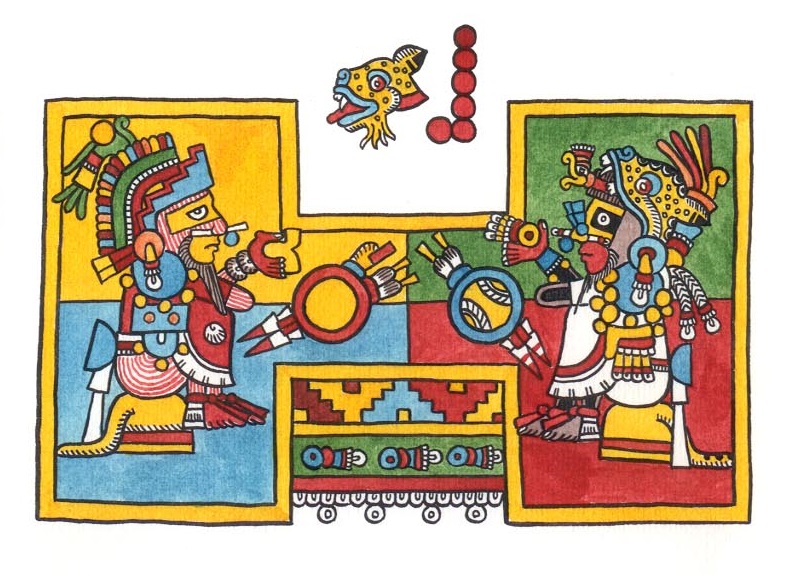Codex Zouche-Nuttall on:
[Wikipedia]
[Google]
[Amazon]
The Codex Zouche-Nuttall or Codex Tonindeye is an accordion-folded British Library, Codex Zouche-Nuttall
/ref>

Facsimile edition
Introduction by Dr. Nancy Troike, University of Texas at Austi
Timeline of Mexico, 1000–1400 AD
Online pdf copy
* * *Facsimile: Codex Zouche-Nuttall; London, British Library, Add MS 39671, Akademische Druck- u. Verlagsanstalt (ADEVA) Graz 1987. Complete colour facsimile edition of the Mixtec pictorial manuscript in the possession of British Library, London, 96 fol., size: 245 x 191 mm, total length: 11,22 metres, in leporello folding; Commentary: Preface in German by F. Anders, Vienna. “Notes on the Codex Zouche-Nuttall” in English by N. P. Troike, Austin. Altogether 60 pp. Facsimile and introductory text encased in box with leather spine. CODICES SELECTI, Vol. LXXXIV *Robert Lloyd Williams: The Complete Codex Zouche-Nuttall: Mixtec Lineage Histories and Political Biographies (The Linda Schele Series in Maya and Pre-Columbian Studies) 2013, University of Texas Press, {{Commonscat 14th-century books Zouche-Nuttall Artefacts from Africa, Oceania and the Americas in the British Museum Mexico–United Kingdom relations
pre-Columbian
In the history of the Americas, the pre-Columbian era spans from the original settlement of North and South America in the Upper Paleolithic period through European colonization, which began with Christopher Columbus's voyage of 1492. Usually, ...
document of Mixtec
The Mixtecs (), or Mixtecos, are indigenous Mesoamerican peoples of Mexico inhabiting the region known as La Mixteca of Oaxaca and Puebla as well as La Montaña Region and Costa Chica Regions of the state of Guerrero. The Mixtec Cult ...
pictography
A pictogram, also called a pictogramme, pictograph, or simply picto, and in computer usage an icon, is a graphic symbol that conveys its meaning through its pictorial resemblance to a physical object. Pictographs are often used in writing and gr ...
, now in the collections of the British Museum
The British Museum is a public museum dedicated to human history, art and culture located in the Bloomsbury area of London. Its permanent collection of eight million works is among the largest and most comprehensive in existence. It docum ...
. It is one of about 16 manuscripts from Mexico that are entirely pre-Columbian in origin. The codex derives its name from Zelia Nuttall, who first published it in 1902, and Baroness Zouche, its donor./ref>
Description
The Codex Zouche-Nuttall was probably made in the 14th century and is composed of 47 sections of animal skin with dimensions of 19 cm by 23.5 cm. The codex folds together like a screen and is vividly painted on both sides, and the condition of the document is by and large excellent. It is one of three codices that record the genealogies, alliances and conquests of several 11th and 12th century rulers of a small Mixtec city-state in highlandOaxaca
Oaxaca ( , also , , from nci, Huāxyacac ), officially the Free and Sovereign State of Oaxaca ( es, Estado Libre y Soberano de Oaxaca), is one of the 32 states that compose the Federative Entities of Mexico. It is divided into 570 municipaliti ...
, the Tilantongo kingdom, especially under the leadership of the warrior Lord Eight Deer Jaguar Claw (who died in the early twelfth century at the age of fifty-two).
Provenance
The codex probably reached Spain in the 16th century. It was first identified at the Monastery of San Marco, Florence, in 1854 and was sold in 1859 to John Temple Leader who sent it to his friendRobert Curzon, 14th Baron Zouche
Robert Curzon, 14th Baron Zouche (16 March 1810 – 2 August 1873), styled The Honourable Robert Curzon between 1829 and 1870, was an English traveller, diplomat and author, active in the Near East. He was responsible for acquiring several import ...
. A facsimile was published while it was in the collection of Baron Zouche by the Peabody Museum of Archaeology and Ethnology
The Peabody Museum of Archaeology and Ethnology is a museum affiliated with Harvard University in Cambridge, Massachusetts. Founded in 1866, the Peabody Museum is one of the oldest and largest museums focusing on anthropological material, wi ...
, Harvard in 1902, with an introduction by Zelia Nuttall (1857–1933). The British Museum was loaned the manuscript in 1876 and acquired it in 1917.

See also
* Codex Waecker-Gotter, in the British MuseumReferences
Facsimile edition
Introduction by Dr. Nancy Troike, University of Texas at Austi
Timeline of Mexico, 1000–1400 AD
Bibliography
*E.H. Boone, Stories in red and black: pict (Austin, University of Texas Press, 2000) * *G. Brotherstone, Painted books of Mexico (London, The British Museum Press, 1995) *C. McEwan, Ancient Mexico in the British (London, The British Museum Press, 1994) *F. Anders, M. Jansen and G. A. Pérez Jiménez, Códice Zouche-Nuttall, facsimile with commentary and line drawing (Madrid, Sociedad Estatal Quinto Centenario; Graz, Akademische Druck-u. Verlagsanstalt; Mexico City, Fondo de Cultura Económica, 1992Online pdf copy
* * *Facsimile: Codex Zouche-Nuttall; London, British Library, Add MS 39671, Akademische Druck- u. Verlagsanstalt (ADEVA) Graz 1987. Complete colour facsimile edition of the Mixtec pictorial manuscript in the possession of British Library, London, 96 fol., size: 245 x 191 mm, total length: 11,22 metres, in leporello folding; Commentary: Preface in German by F. Anders, Vienna. “Notes on the Codex Zouche-Nuttall” in English by N. P. Troike, Austin. Altogether 60 pp. Facsimile and introductory text encased in box with leather spine. CODICES SELECTI, Vol. LXXXIV *Robert Lloyd Williams: The Complete Codex Zouche-Nuttall: Mixtec Lineage Histories and Political Biographies (The Linda Schele Series in Maya and Pre-Columbian Studies) 2013, University of Texas Press, {{Commonscat 14th-century books Zouche-Nuttall Artefacts from Africa, Oceania and the Americas in the British Museum Mexico–United Kingdom relations